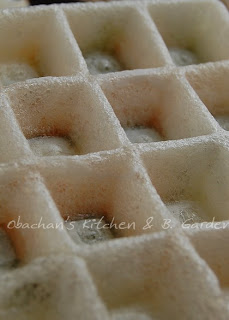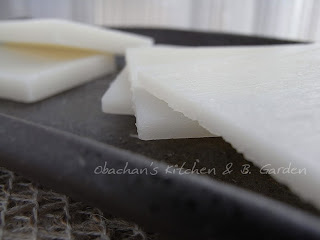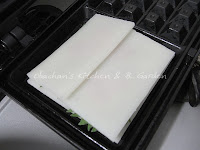|
Saturday, February 28, 2009
Savory Waffles...?
Posted by
obachan
at
2/28/2009 07:23:00 PM
7
comments
![]()
Labels: Bread/Pancakes
Thursday, February 26, 2009
Look! More Moffles! -1-
Just a couple more experimental batches to follow my previous moffle post. To make these two types of moffles, I used thin mochi (rice cakes) and VERY thin ones. The dessert moffle in the first photo was made by making plain moffles with the thin rice cakes and topping them with the sweets. The savory variety in the second photo was made with the very thin rice cakes called shabu-shabu mochi, with the filling being sandwiched between them. FYI, the shabu-shabu mochi is very thinly sliced and named so because it is used for a Japanese hot-pot dish called shabu-shabu. When you eat shabu-shabu, you swish thinly sliced meat or cut vegetables in boiling dashi broth a few times and dip in dipping sauce and eat immediately. To be eaten that way, the rice cake needs to be very thin so that it softens quickly. (This shows you what it looks like when eaten in shabu-shabu.) Now, here's how I made the savory, sandwich-like moffles. It's recommended to place one edge of the rice cake on that of the other one. That way, you can prevent the filling oozing out from the gap between the two rice cakes before they become soft and stick to each other. To be honest, I wasn't too impressed with the dessert moffle above. The cheap matcha ice cream didn't have a good flavor in the first place, and the moffles tasted rather bland. Besides, the moffles turned rather soggy than soft while I was taking the photos. Maybe I should have made them with the shabu-shabu mochi with the azuki an as a filling, then topped them with azuki an and ice cream. The savory version was pretty good. :D And it looked so cute with the colors of mentaiko and shiso showing through the moffle crust, like this:  I have a couple more ideas of savory versions, hence more moffle posts to come. (Don't know how soon, though.) Oh I wish shabu-shabu mochi was not that expensive! *** WARNING!! *** To make moffles, here in Japan we use mochi (rice cake) made by pounding steamed glutinous rice. There is a softer type of rice cake made from mochiko (rice flour) -- the mochi used as daifuku skin. Now, I have never ever seen, heard or read about anyone in Japan making moffles using that softer mochi, and I DO NOT recommend anyone to do so because it may stick to the waffle maker and make a mess. Well, it may not -- but we don't know until someone actually gives it a try. ********************* P.S. Great news!! I finally managed to open the jars of my two-year-old cucumber pickles! Of course I'm not gonna eat 'em but so happy to have more space in the fridge and more empty jars in the cupboard... Yay!! :D Categories: Japanese |
Posted by
obachan
at
2/26/2009 10:23:00 AM
13
comments
![]()
Labels: Rice dish
Monday, February 23, 2009
One Step At A Time
My second time making French Baguettes based on this recipe. My twist this time was some black sesame seeds sprinkled on top. The bread tasted much better than the last time, because I had enough time to leaven the dough. But I couldn't slash the top deep enough and I was not satisfied with the way the bread looked. OK. Deeper slashing next time. ;) (I ate half of the loaf today. The rest was sliced, wrapped and put in the freezer.) Categories: Western-inspired |
Posted by
obachan
at
2/23/2009 09:09:00 PM
10
comments
![]()
Labels: Bread/Pancakes
Sunday, February 15, 2009
Soy Milk Mayonnaise
Maybe some of you have heard of macrobiotic diet or macrobiotics? It's becoming more and more popular here in Japan. I don't know much about it at the moment, and probably would not go too deeply into it in the future, either. But macrobiotics seems to suggest many healthier substitution ideas, which I welcome very, very much. Recently I have been doing a net search on such ideas not only for myself but also for my parents who I will be cooking for in the near future. I didn't know this before, but a good number of people here in Japan are on this macrobiotic diet now and trying those substitution ideas. I bet some of the ideas make you go "Yuuuuck! But I should put up with it because it's supposed to be healthy..." and others make you give thumbs-up. Now here is this idea of using soy milk in place of egg yolks to make mayonnaise. Almost all Japanese posts about this mayonnaise I read praised it, except the ones who used olive oil. So I thought it was a right bandwagon to jump on ;) This morning, as soon as I finished breakfast, I made an experimental batch based on a recipe (Japanese) I found last night. Mmmmm.... I give a thumb up to this idea. The taste and the texture are pretty close to real mayonnaise, I think. (I used food processor to whip it up well.) When I first licked it, I thought the salt and vinegar tasted too sharp for me. But it was alright when I tried it on sliced tomatoes. Then later I found out that the idea was already popular outside Japan among vegan people, and hundreds of English recipes of "vegan mayonnaise" are out there on the net. How nice.It seems that vegetarian or vegan diet did not make a great breakthrough in Japan right after it became popular abroad, though Japanese people have been crazy about losing weight for decades. Then now, the needs of young moms with atopic kids, as well as the growing interest in the prevention of cancer or metabolic syndrome, brought macrobiotics into the spotlight, which lead to the introduction of many vegan recipes in Japan. Macrobiotics and veganism are not exactly the same, but they seem to suggest many similar recipes. I could be wrong, but to me it seems that way. When I make the next batch, I might try coloring it to make it look more yellowish. No, not by using termeric. I'm thinking something less expensive... IIRC, Laura Ingalls's Ma would color her homemade butter by using grated carrots, right? I think I read that in Little House on the Prairie... or was it in Little House in the Big Woods? Anyway, I may give it a try next time. ;) P.S. * This does not sound very healthy, but I always drink or use the soy milk with additives. I don't like the taste of pure soy milk... Categories: Western-inspired |
Posted by
obachan
at
2/15/2009 11:25:00 AM
13
comments
![]()
Labels: Salad/Dressing
Saturday, February 14, 2009
More Than Words
Often photos can say much more than words ever will. And what these photos are saying to you on this Valentine's Day is...   ... that obachan failed to bake heart-shaped chocolate cupcakes and made a heart with ribbon instead. LOL Yeah, right. Those paper cups did not look firm enough at the store, but I was optimistic. Unfortunately the optimism didn't pay off, and after my cupcakes swelled up, they looked more like amoeba. :O This one in the photos was the best one (as long as you don't see the other side of it). Well, but that's not the only thing that these photos are telling you, dear readers. They have a more important message, and that is... " Have a special and romantic day with your sweetheart :) " Categories: Sweets |
Posted by
obachan
at
2/14/2009 01:13:00 PM
8
comments
![]()
Labels: Cakes
Thursday, February 12, 2009
Daikon and Hakusai Gyoza
Another recipe from the Jan. 25, 2009 issue of Lettuce Club. It's a low-cal dish that uses thinly sliced daikon radish as gyoza (potstickers) skin and more minced hakusai (Chinese cabbage) than ground meat for the filling. Good recipe for those who can slice daikon in 3 mm thick disks or who have a vegetable slicer like this one.  I loved this gyoza wrapper! :D It was crispier and probably healthier than regular dumpling skin. The only problem with this dish was having to use salt to soften the daikon wrappers and minced Chinese cabbage. I should have used less salt when seasoned the filling... My gyoza tasted just a little too salty, and probably the salt wasn't very good for my relatively high blood pressure. ------- (Added Feb. 14) Wow! I didn't think this many people would be attracted to this dish. OK. Let me add a little more information here. About daikon wrapper: You don't need to peel the daikon. Wash it well and slice it with the skin on. Spread the thin daikon disks on a flat surface and sprinkle both sides with a little salt. Sorry, I don't remember how long I waited and the recipe doesn't say anything about this... Just try folding one of them. If it folds as much as the wrappers in these photos do without breaking, it's ready. (Now the original recipe didn't say anything about this but I washed off the salt with running water when the daikon wrappers became soft enough.) Pat-dry them with paper towel. Then spread them on a flat surface and sprinkle one side with potato or corn starch using a tea strainer or something just to thinly cover the surface. This should keep the filling in the wrapper. ;) Put the filling on each wrapper and fold it. About the filling: The ingredients are ground pork, minced veggies (hakusai cabbage, green onion, ginger and garlic), salt, pepper, potato (or corn) starch, sesame oil, sake and soy sauce. The minced hakusai needs to be softened beforehand and you do this by mixing in a little salt and leaving it for a while (again, the recipe doesn't say how much salt or leave it how long). While waiting, you can mix other ingredients and seasonings in a bowl, and when the minced hakusai is soft enough, squeeze the water off it and mix in. I didn’t wash off the salt from the hakusai there and that’s why I wrote “I should have used less salt when seasoned the filling” above. Frying: And when you fry the gyoza with a little vegetable oil in a frying pan, fry both sides of the gyoza first to slightly brown them, then put a lid on the pan to sort of “steam-fry” them over low heat until the filling is done. I didn't need to add water because enough water came out from the veggies. And the best tip I can give you here is: If the filling comes out, just put it back in the wrapper! Yep, THIS is the secret. LOL ** One question. What do you call these in English? Sorry. Maybe I should give more explanation. They are not used for baking (though I assume that they could stand the heat of the oven.) They are usually used for keeping prepared food or ingredients like chopped vegetables or filleted fish or wrapped gyoza that are ready to be fried, etc. Most often we put food in them, cover with plastic food wrap and keep in the fridge. They are called "stainless vat (pronounced 'batto')" or "kitchen vat" here, but I've been wondering if the word "vat" came from English. Categories: Asian-inspired |
Posted by
obachan
at
2/12/2009 11:20:00 PM
20
comments
![]()
Labels: Vegetables
Tuesday, February 10, 2009
Pickled Cherry Tomatoes
Some of you might remember what I wrote about my experience with cucumber pickles before. It was a little -- well, VERY -- disappointing experience. Actually it was almost traumatic, considering the amount of time I spent on the conversion. (It was an American recipe I found on the net.) Since then, I had avoided thinking about pickling again, until I saw a real tempting photo of pickled cherry tomatoes with a recipe in an old issue of a cooking magazine the other day. Isn't it amazing how photos can influence or motivate people to do something? Or maybe it's just me? I get tempted so easily... SOMETIMES (not always, I guess).  Well, this time I'm really happy that I got tempted. The recipe required no conversion, the instruction was very simple and the pickles turned out oh so good, though I needed to add much more sugar than the recipe called for to suit my taste.  And these pickles in the jar are so photogenic! That really counts.  And you see the jar I chose this time? Hey, I'm learning... ;) Categories: Western-inspired |
Posted by
obachan
at
2/10/2009 03:48:00 PM
8
comments
![]()
Labels: Vegetables
Wednesday, February 04, 2009
Tea Break
The fact that I'm posting this at this time of the day means that I'm not at work this morning. Yep, I only need to work at night today, and as you can probably figure out from these photos, it's a nice, sunny day. I finished doing my laundry and now I'm going to spend the rest of the morning and early afternoon posting this and responding to the comments to my blog. And these cookies are the munchies to accompany the green tea while I'm sitting in front of my laptop.  These are supposed to be healthy, guilt-free, low-cal cookies with no eggs or dairy products used. The recipe is here (Japanese) if you're interested, and all the ingredients are just flour, sugar, black sesame seeds, salt and canola oil. Healthy, isn't it? These are supposed to be healthy, guilt-free, low-cal cookies with no eggs or dairy products used. The recipe is here (Japanese) if you're interested, and all the ingredients are just flour, sugar, black sesame seeds, salt and canola oil. Healthy, isn't it?But when I first tried out this recipe, I thought these cookies were a little too crumbly. And though I liked the simple taste of sugar and sesame seeds with the salt as an accent, I couldn't help feeling that I'd rather add one more ingredient -- something to harmonize the sweetness, saltiness and sesame flavor. So what I chose as a relatively healthy solution was adding a little soy milk. I think it was not a bad idea, though not the best. Next time I might add less amount of soy milk and substitute the sugar with maple syrup.  Oh, BTW, this mat in these photos is the one I made myself at the weaving workshop years ago. (Actually, 2005.) Categories: Sweets |
Posted by
obachan
at
2/04/2009 10:46:00 AM
11
comments
![]()
Labels: Cookies
































